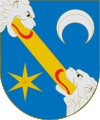Banda de Castilla
Banda de Castilla , the ribbon of Castile , has become the Spanish coat of arms over a flag . The herald's image has its origin in the Spanish knightly order Orden de la Banda . It is only shown on war flags and later on coats of arms. It was considered a symbol of the Castilian kings. From Alfonso XI. The order was founded in 1330/1332 for the reward of those who were loyal to the king and to strengthen royal power, but as a sign of the order had no uniform color and image. It was not until Henry IV of Castile that a uniform, now known and widespread representation was established and handed down.
A heraldic diagonally right-lying band with different ends is the coat of arms. At the ends there can be dragon heads, lion heads or snakes looking at each other. The color differs from the flag display very different in the heraldry. The flag as a template is in red and the ribbon in gold, as well as the animal heads. The flag as Real de Castilla La Banda was the emblem of dictator Francisco Franco from 1940 until his death. Around 1940 it was changed by the introduction of the pillars of Hercules in the free corners.
In modern times, various Spanish communities have included the Banda de Castilla in their coat of arms. These include: Aulestia, Gautegiz Arteaga, Moeche, Munitibar-Arbatzegi Gerrikaitz, Villamanrique de Tajo. The picture shows the coat of arms of San Andrés y Sauces .











